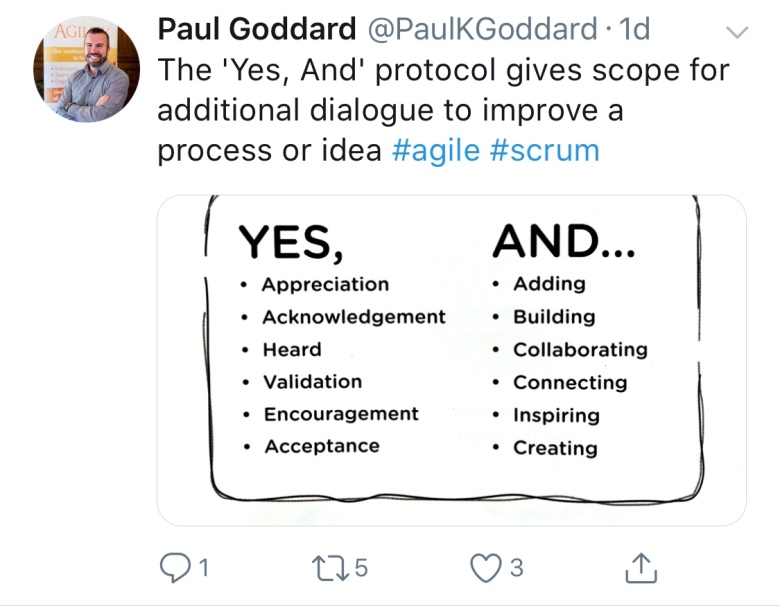Last week I saw a tweet by Paul Goddard, an Agile Coach and Certified Scrum Trainer that reminded me of a very powerful technique ‘Yes, and’ used for team collaboration and generating ideas.
I have known ‘Yes, and’ protocol from the improvisational comedy and self-development workshops I attended within the leadership programme of the non-profit organisation Toastmasters International.
However, I’ve just now realised how the protocol can be used when working with multidisciplinary agile teams on IT projects as well as non-IT projects delivering process improvement or other deliverables.
The technique was originated in the improvisational comedy that suggests a person accepts what the other person has stated ‘Yes’ and builds on that line of thinking ‘and’. It’s my favourite improv exercise which has helped me think on my feet and improve my listening skills and quick reactions.
Why is this technique so powerful is exactly the opposite of saying ‘Yes, but’. After ‘Yes, but’ nothing innovative can be created whereas after saying “Yes, and’, a lot of ideas and options are open for discussion.
‘Yes, but’ phrase has unfortunately stuck in people’s language so much that it will need to take some time to unlearn it and start using “Yes, and’ at all times unless you really want to turn an idea down for example when convincing the client that something may not be a proper use of their budget.
In order to find out how useful the technique is in a real life situation, I’ve decided to organise a workshop within the Agile Coaching sessions I run at Government Digital Service, UK government.
The ‘Yes, and’ technique can be widely used in any discipline. It is helpful in product design when developing personas and exploring concepts or in software development when you look for the best technical solution or reveal gaps and missing requirements.
Moreover, you can use the ‘Yes, and’ technique in larger groups of 10-20 people. I have tested it with my workshop group and the feedback was very positive. The participants found it very easy to use, follow up on what’s been said and gradually add more ideas to the proposed solution. It worked very well and it has become one of our creative tools to stimulate positive conversations.
‘Individuals and interactions over processes and tools‘ is one of the values of Agile Manifesto and using the ‘Yes, and’ protocol can significantly improve team collaboration and build the environment where everyone is encouraged to speak up and share their ideas.
